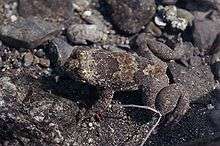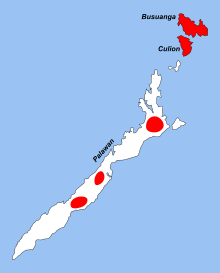Philippine flat-headed frog
| Barbourula busuangensis | |
|---|---|
 | |
| Scientific classification | |
| Kingdom: | Animalia |
| Phylum: | Chordata |
| Class: | Amphibia |
| Order: | Anura |
| Family: | Bombinatoridae |
| Genus: | Barbourula |
| Species: | B. busuangensis |
| Binomial name | |
| Barbourula busuangensis Taylor & Noble, 1924 | |
 | |
The Philippine flat-headed frog (Barbourula busuangensis) is a species of frog in the Bombinatoridae family. It is also known under the common names "Busuanga jungle toad", "Philippine aquatic frog", "Busuanga disk-tongued toad", and "Busuanga discoglossid frog" (the last two names reflect the earlier placement of the genus Barbourula in the family Discoglossidae, but are misleading under current taxonomy). It is endemic to the Busuanga, Culion, Balabac, and Palawan islands in the Philippines.[2] Its natural habitats are tropical dry forests, moist lowland forests, moist montane forests, rivers, and intermittent rivers. It is threatened by habitat loss.[1]
Description
The Philippine flat-headed frog is a large aquatic species of frog. Its body is flattened dorso-ventrally and its nostrils and eyes are located at the top of its head. It has no external tympani. Both fore and hind limbs are robust and powerful and the digits of the hands are webbed as well as those of the feet. The surface of the body is covered with fine tubercles. This frog is a dark greenish-black in colour with some faint pale green hatching and spotting on the hind limbs.[3]
Distribution and habitat
This frog is endemic to the western Philippines where it is present on Busuanga, Culion and Palawan. Its presence in a location is easily overlooked and it may have a wider range than is currently known. Its typical habitat is fast-flowing, unpolluted streams in lowland tropical forests. It often floats on the surface, but is very wary and dives to the bottom and hides if it is disturbed.[1]
Breeding
Little is known of the breeding habits of this rare species and tadpoles have not been observed. Pregnant females have been found with a small number of large, unpigmented eggs. This led researchers to hypothesize that development may be direct without an intervening tadpole stage. Attempts to get the species to breed in the laboratory have been unsuccessful.[3]
Status
The IUCN lists this frog as "Vulnerable". The reasons given are that it has a total range of less than 20,000 square kilometres (7,700 sq mi), its populations are fragmented and its numbers are declining. The main threats it faces are degradation of its habitat, changing agricultural practices, quarrying, mining and pollution of the streams with runoff from agricultural land.[1]
References
- 1 2 3 4 Diesmos, A.; Alcala, A.; Brown, R.; Afuang, L.; Gee, G.; Hampson, K.; Diesmos, M.L.; Mallari, A.; Ong, P.; Ubaldo, D.& Gutierrez, B. (2004). "Barbourula busuangensis". IUCN Red List of Threatened Species. Version 2013.1. International Union for Conservation of Nature. Retrieved 21 October 2013.
- ↑ Frost, Darrel R. (2013). "Barbourula busuangensis Taylor and Noble, 1924". Amphibian Species of the World 5.6, an Online Reference. American Museum of Natural History. Retrieved 21 October 2013.
- 1 2 Carlos R. Infante (2003-05-01). "Barbourula busuangensis". AmphibiaWeb. Retrieved 2013-12-11.
External links
-
 Media related to Barbourula busuangensis at Wikimedia Commons
Media related to Barbourula busuangensis at Wikimedia Commons
